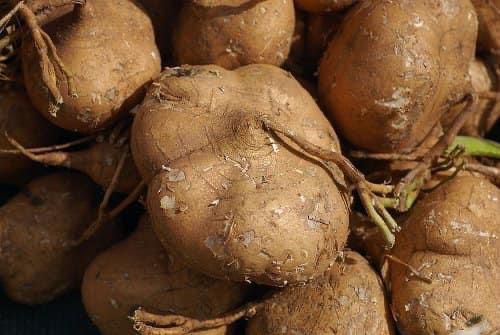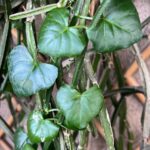As I had announced earlier I will be publishing a series of Asha Krishna’s posts on Vegetables. She is a lovely resident here, who is doing an important job of saving the heirloom varieties. I am sorry I have not been posting so regularly, but the pressures of a new job and my own garden have eaten away at my time.
Below are Asha’s own words about Jicama.
It is a lesser-known, underutilized, neglected wild edible plant species. The botanical name is Pachyrhizus erosus. In English, it is called Jicama / Mexican yam bean / Mexican turnip / Potato bean/ Chinese potato/ Mexican potato/ Mexican water chestnut/ leaf cup/ Mexican turnip
Jicama is a root vegetable with thick, brown skin. It’s white inside and tastes like an apple but not as sweet. It’s a bit like a potato but with a lot fewer carbs.
The Jicama plant grows mostly in Mexico and Central America on a long vine. But the part you eat is the root.
On the outside, the jicama looks like a light brown beet. Inside, it looks and feels like a raw potato. But it doesn’t taste like one. It’s crisp and slightly sweet, like an apple. But jicama doesn’t brown like an apple after you cut it.



Jicama Nutrition
One medium-sized jicama has:
● 250 calories
● 32 grams of fiber
● 12 grams of sugar
● 4 grams of protein
● 15%-19% of your daily recommended vitamin C
Jicama’s Health Benefits
-Tater twin. People often compare jicama to potatoes because their flesh is similar. But jicama is much healthier and has far fewer carbohydrates.
-Fun way to get fiber. Instead of an apple, peel and slice a jicama and dip it in a nut butter. It’s a fiber-packed snack that prevents constipation, lowers cholesterol, and lowers your chances of getting colon cancer and heart disease.
-Vitamin C. This vitamin gives a big boost to the immune system — your body’s defense against germs. It’s also good for your eyes and skin. And it lessens inflammation in your body, which can cause arthritis and other diseases.
-Vitamin B-6. Jicama has this key vitamin, which supports your brain and nerves, forms red blood cells, and turns protein into energy.
-Antioxidants. Jicama has several of these compounds, which help prevent cell damage. Getting enough antioxidants from food has been linked with a lower risk of cancer, diabetes, heart disease, and cognitive decline.
-Boosts heart health. Jicama has dietary fiber, which may lower cholesterol levels.
-Prebiotic. Jicama is rich in a type of prebiotic fiber that helps restore the good bacteria in your gut.
-Helps with hydration. Jicama is 85% water. Use it to help you stay hydrated, especially when it’s hot outside.
-Safe for blood sugar. If you’re watching your blood sugar and insulin, jicama is a safe snack. It has carbs, but they have a low glycaemic load, which means the carbs don’t affect your blood sugar very much.
Jicama Risks
Only the flesh of the root vegetable itself is safe to eat. Jicama’s skin, stem, leaves, and seeds are poisonous.
How to Prepare Jicama?
● Choose a jicama that’s small, heavy, and firm and has smooth skin.
● Wash it well and cut off any roots.
● Use a paring knife or vegetable peeler to remove the skin completely, including the paper-like layer underneath.
● After you peel it, cut it in half to make it easier to manage. Then cut it into cubes, sticks, or slices, or you can shred it.
How to Eat Jicama
Most people eat jicama raw with salt, lemon or lime juice, and chili powder sprinkled on top. You can also:
● Pickle it.
● Make a slaw out of it.
● Use it to add crunch and extra vitamins to salads.
● Serve it like cucumber on vegetable platters or with sushi.
● Add it to stews, soups, or stir-fries.
● Cook and mash it like a potato.
● Cut it into long strips, toss with oil, and fry it.
How to Store Jicama
Keep whole, unpeeled jicama dry and unwrapped in a cool area for 2 to 3 weeks. Once you cut it, wrap up your jicama tightly and store it in the refrigerator for a week.
#food_is_medicine #locally_grown #heirloom_seeds #endangered_seeds #know_what_you_grow #seed_story #EM1 #bokashi_composting #sustainable_farming
I will now add my two bits. This plant can grow from seed or tuber. The leaves, pods, and beans are poisonous, in fact, they were used in organic insecticide. It was later found that this was quite harmful to humans and the beneficial insects as well so was discontinued.
Plant seeds or a part of the tuber here in the Gulf in early September as the plants need warm soil. Jicama prefers rich, moist, sandy loam soil with good drainage that is high in potassium. During summer, please move it away from the full sun and give it some shade. Early morning or late evening sun is fine. You can keep in the full sun until early to mid-May.
Since it needs a lot of potassium, using banana peel powder to fertilize is good. Using Rabbit manure also helps a lot as well as using organic ferments made from Banana peels and Onion Peels. Make sure you trim off the pods (just keep some pods to dry on the plant for seeds for next season) and the flowers regularly as this increases the size of the tuber which is what we can eat. Asha Krishna and Mr. Essa Al Daboos are growing this at their farm in Abu Dhabi. I am sure we shall be hearing more about this little-known but fabulous food source from them soon






Recent Comments